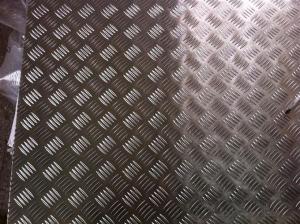Five Bar Anti-slip Bus Aluminum Tread Plate Manufacturer
- Loading Port:
- Shanghai
- Payment Terms:
- TT OR LC
- Min Order Qty:
- 2.5
- Supply Capability:
- 5000 m.t./month
OKorder Service Pledge
OKorder Financial Service
You Might Also Like
Item specifice
Five Bar Anti-slip Bus Aluminum Tread Plate Manufacturer
lProduct Information
1.Alloy :1060,1100,3003,5052,5754,6061,6063,6082
2.Temper: H14,H18,H12,H16,H22,H26,H24,T3,T4,T6
3.Brand: CMAX
4.Thickness: 0.8-10.0mm. width: 20-1650mm. length:500-16000mm
5.Tolerance: thick +/-0.02mm, width +/-0.5mm.
6.Pattern:One bar, Two bars, Three bars, Five bars and Diamond.
7.Surface brightness: bright surface or normal surface.
8.Application: trailer, truck, decking, flooring, stairs, steps, building industry.
9.Loading port: Shanghai port, or main port in China
lPackaging & Delivery Details
Packaging: Standard seaworthy packing
Delivery: About 25 days after received your advance
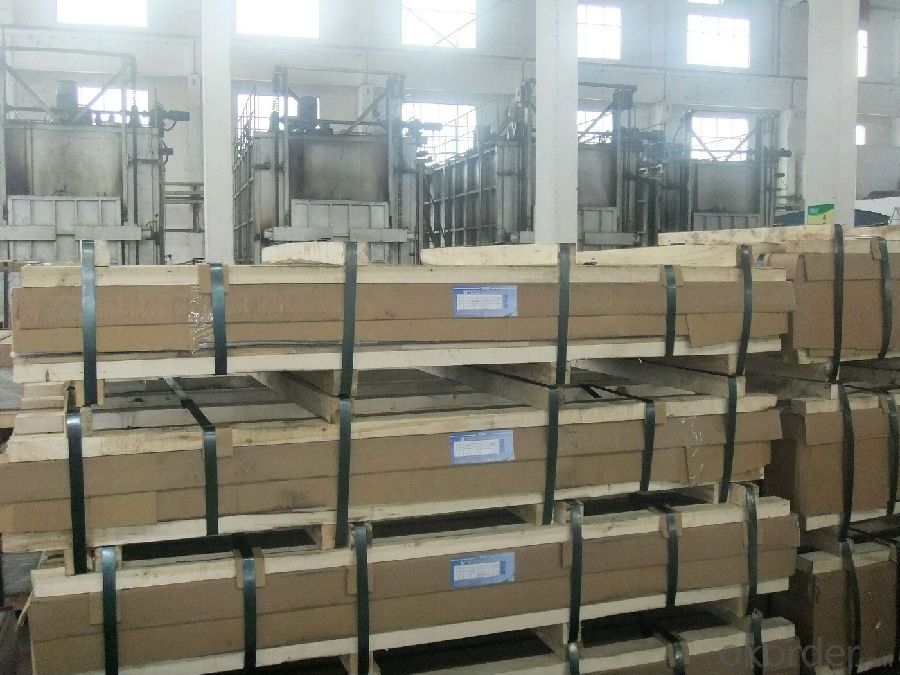
lCompany Profile
CNBM International Corporation, China National Building Materials (Group) Corporation, is one of the largest companies in China building
material & equipment industry, with 42,800 employees and sales in 2005 of US Dollar 4.395 billion. In 2006, China National Building Material Company Limited was listed on Hong Kong Stock Market with the stock code as 3323.
CNBM has been involved in aluminium products for about a decade. With advanced technology and equipment, our products have been sold to the worldwide including America, Europe, as well as South Asia, etc.
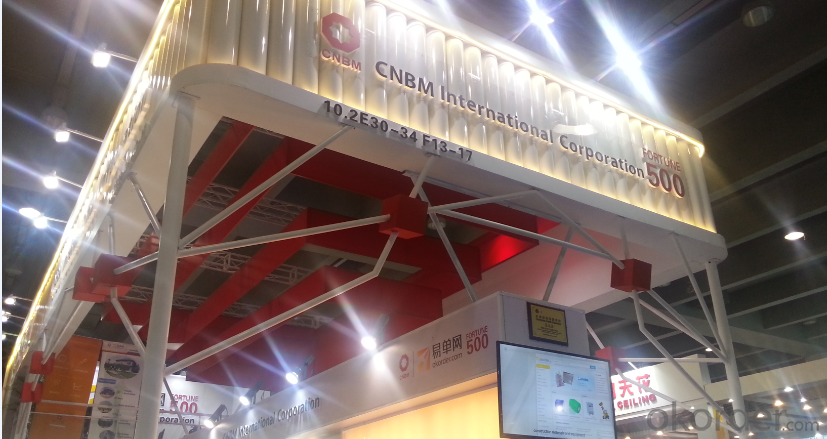
lProduct Images
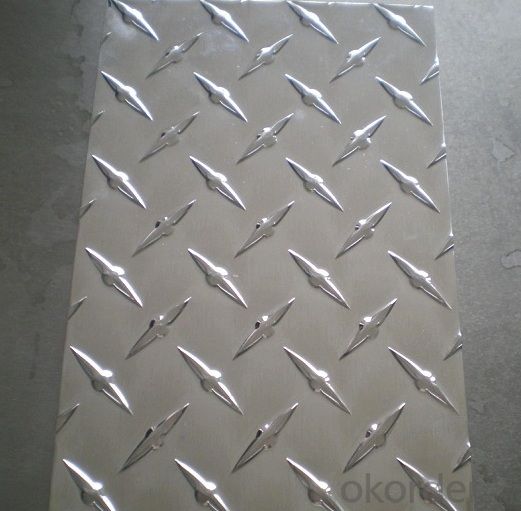

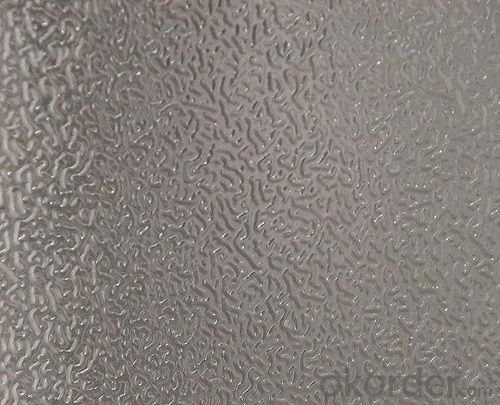
lCertificates
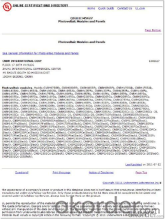
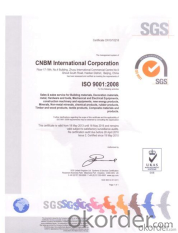
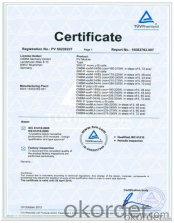
lFAQ
Q: Do you provide free samples?
A: Yes, free samples will be sent to you on freight at destination.
Q: Can I get your latest products catalogue?
A: Yes, it will be sent to you in no time.
Q: What is the MOQ?
A: 2.5 tons
- Q:How does the surface roughness of aluminum sheet affect its performance?
- The overall performance of an aluminum sheet can be greatly influenced by its surface roughness. The roughness of the sheet's surface refers to the presence of irregularities, bumps, and texture. Various methods, such as Ra or Rz, can be used to measure these irregularities. One important effect of surface roughness on aluminum sheet performance lies in its ability to bond with other materials. A smoother surface allows for better adhesion, whether through welding, gluing, or painting. In contrast, a rough surface reduces the contact area and weakens the bond. This is particularly crucial in applications where the aluminum sheet is used structurally or in manufacturing processes that require strong adhesion. Surface roughness also affects the sheet's light reflection capabilities. A smoother surface reflects light more uniformly, resulting in a higher level of reflectivity. On the other hand, a rough surface scatters light in different directions, decreasing overall reflectivity. This property is relevant in applications like architectural cladding, where the desired aesthetic appearance depends on consistent light reflection. Additionally, the surface roughness of aluminum sheets can impact their resistance to corrosion. A smoother surface is less susceptible to corrosion as it provides fewer sites for corrosion to start. Conversely, a rougher surface may contain micro crevices or grooves that can trap moisture, salts, or other corrosive substances, speeding up the corrosion process. Maintaining a smooth surface is crucial in applications where corrosion resistance is vital, such as marine environments or outdoor structures. Lastly, surface roughness affects the mechanical properties of the sheet. A rough surface can concentrate stress, making the sheet more prone to fatigue, cracks, or other mechanical failures. Smoother surfaces distribute stress more evenly, enhancing the sheet's overall strength and resistance to deformation. In conclusion, the surface roughness of an aluminum sheet is of utmost importance in determining its performance. It affects adhesion, reflectivity, corrosion resistance, and mechanical properties. Therefore, it is essential to consider and control surface roughness in various applications to ensure optimal performance and longevity of aluminum sheets.
- Q:What are the different methods of surface engraving aluminum sheets?
- There are several methods of surface engraving aluminum sheets, including laser engraving, mechanical engraving, chemical etching, and diamond drag engraving. Each method offers different levels of precision and depth, allowing for various artistic or functional purposes.
- Q:Can aluminum sheets be bent or formed into different shapes?
- Certainly, aluminum sheets possess the capability to be bent or molded into diverse configurations. This metal, aluminum, possesses remarkable malleability, signifying that it can be effortlessly shaped or molded without experiencing any fractures or fissures. This characteristic renders it highly adaptable for an array of industries and applications. By bending, rolling, or pressing aluminum sheets, an assortment of shapes or structures can be brought to life, including cylinders, cones, or intricate geometric formations. The capacity to bend or mold aluminum sheets unveils an extensive scope of opportunities for the manufacturing, construction, automotive, aerospace, and countless other sectors.
- Q:What is the fatigue strength of aluminum sheets?
- The fatigue strength of aluminum sheets can vary based on several factors, including the composition of the alloy, thickness, condition of the surface, and the specific loading conditions. When compared to other metals, aluminum alloys typically exhibit favorable fatigue strength. To determine the fatigue strength of aluminum sheets, fatigue testing is commonly employed. This involves subjecting specimens to cyclic loading until failure. The fatigue behavior of aluminum sheets is characterized by the S-N curve, which represents the relationship between the applied stress amplitude (S) and the number of cycles to failure (N). Aluminum alloys, such as 2024-T3 and 6061-T6, are frequently used in industries like aerospace and automotive due to their high fatigue strengths. These alloys can endure millions of cycles at specific stress levels. For instance, at 10^6 cycles, 2024-T3 aluminum alloy has a fatigue strength of approximately 105 MPa (15,000 psi), while 6061-T6 aluminum alloy has a fatigue strength of around 96 MPa (14,000 psi). It is worth noting that the fatigue strength of aluminum sheets can be influenced by various factors, including surface defects, corrosion, temperature, and loading frequency. To enhance the fatigue strength, it is important to properly prepare the surface by smoothing it and eliminating sharp edges. Additionally, the use of appropriate stress relief treatments and design considerations, such as avoiding stress concentrations and optimizing joint design, can also improve the fatigue performance of aluminum sheets. In conclusion, the fatigue strength of aluminum sheets is generally considered good. However, it is crucial to consider the specific alloy, thickness, surface condition, and loading conditions in order to accurately determine and optimize the fatigue performance in practical applications.
- Q:the coil is wrapped around the aluminium pipe will it effect the efficiency of the coil gun ?
- I think it will make it totally non-functional. Since the aluminum pipe will act like a shorted turn and aluminum happens to be a very good conductor, the pipe will absorb most of the flux produced by the coils and turn it into electric current and heat. With the result being almost no flux gets to the projectile. So if you consider going from 90% to 0.05% a significant effect on efficiency, then yes. The pipe must be made out of a non-conductive material. Or at the very least, it needs to be cut so there is no complete path for current around it's radius.
- Q:Can aluminum sheets be bent without breaking?
- Yes, aluminum sheets can be bent without breaking. Aluminum is a highly malleable and ductile metal, which means it can be easily shaped and bent without fracturing or cracking. This property makes aluminum an ideal material for various applications, including the manufacturing of aircraft, automobiles, and household items. The flexibility of aluminum sheets allows for the creation of intricate designs and complex shapes, making it a highly versatile material. However, it is important to note that the thickness and grade of the aluminum sheet can influence its bendability. Thicker sheets may require more force and specialized tools to achieve the desired bend, while softer grades of aluminum may be more easily bent.
- Q:i am writing an essay about aluminium recycle,,,, and i would like to knowwhy it is important to recycle aluuminium can, what is so harmful about the wastes and some facts about aluminium.Thanx..... i would love if you give me the site address where i can find such infors...
- aluminium okorder /
- Q:How do aluminum sheets perform in terms of fire resistance?
- Aluminum sheets have excellent fire resistance properties. Aluminum is a non-combustible material, meaning it does not burn or contribute to the spread of fire. In fact, aluminum has a high melting point of around 660 degrees Celsius (1220 degrees Fahrenheit), which makes it highly resistant to heat. When exposed to fire, aluminum forms a thin layer of oxide on its surface, which acts as a protective barrier against further oxidation. This oxide layer is highly stable and helps to prevent the material from igniting or releasing flammable gases. Additionally, aluminum sheets have low thermal conductivity, which means they do not transfer heat as easily as other metals, further enhancing their fire resistance. These fire-resistant properties make aluminum sheets a preferred choice in various applications where fire safety is a concern, such as building construction, aerospace industry, automotive manufacturing, and electrical enclosures. Aluminum sheets are often used in exterior cladding, roofing, and insulation systems, where they provide an additional layer of protection against fire hazards. It is important to note that while aluminum sheets themselves are highly fire-resistant, the overall fire performance of a structure or system depends on the design, installation, and other materials used in combination with aluminum sheets. Therefore, it is crucial to follow appropriate fire safety regulations and guidelines to ensure optimal fire resistance in any given application.
- Q:need help choosing an aluminum welder at a descent price also
- i think, welding,,, tig is right machine for aluminum, thank you.
- Q:Can aluminum sheets be textured or patterned?
- Yes, aluminum sheets can be textured or patterned. There are various techniques that can be used to create textures or patterns on aluminum sheets, such as embossing, engraving, or etching. These methods involve altering the surface of the aluminum sheet to create a desired texture or pattern. Additionally, aluminum sheets can also be coated or painted with different finishes or colors to achieve a specific textured or patterned appearance. Overall, with the right techniques and processes, aluminum sheets can be transformed and customized to have a wide range of textures and patterns.
1. Manufacturer Overview |
|
|---|---|
| Location | |
| Year Established | |
| Annual Output Value | |
| Main Markets | |
| Company Certifications | |
2. Manufacturer Certificates |
|
|---|---|
| a) Certification Name | |
| Range | |
| Reference | |
| Validity Period | |
3. Manufacturer Capability |
|
|---|---|
| a)Trade Capacity | |
| Nearest Port | |
| Export Percentage | |
| No.of Employees in Trade Department | |
| Language Spoken: | |
| b)Factory Information | |
| Factory Size: | |
| No. of Production Lines | |
| Contract Manufacturing | |
| Product Price Range | |
Send your message to us
Five Bar Anti-slip Bus Aluminum Tread Plate Manufacturer
- Loading Port:
- Shanghai
- Payment Terms:
- TT OR LC
- Min Order Qty:
- 2.5
- Supply Capability:
- 5000 m.t./month
OKorder Service Pledge
OKorder Financial Service
Similar products
New products
Hot products
Hot Searches
Related keywords
